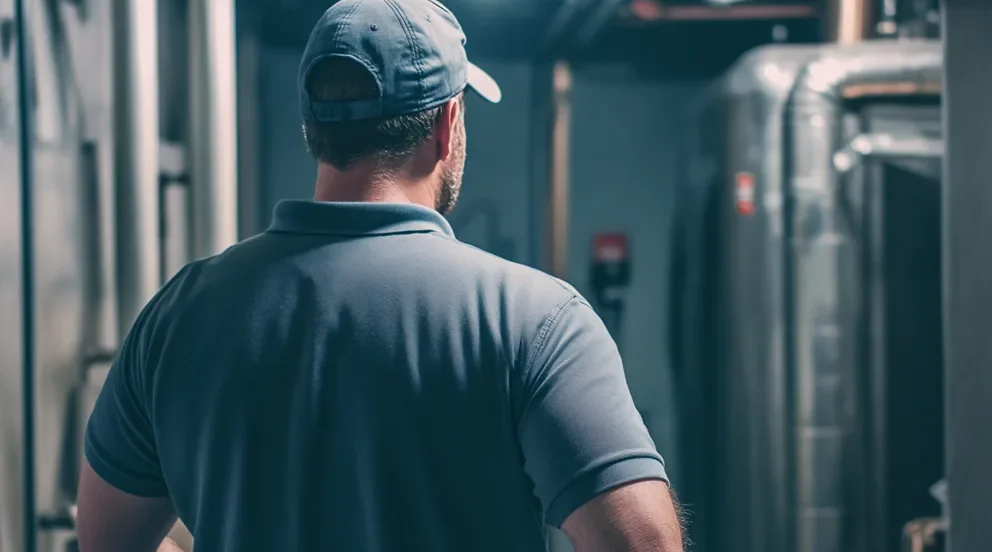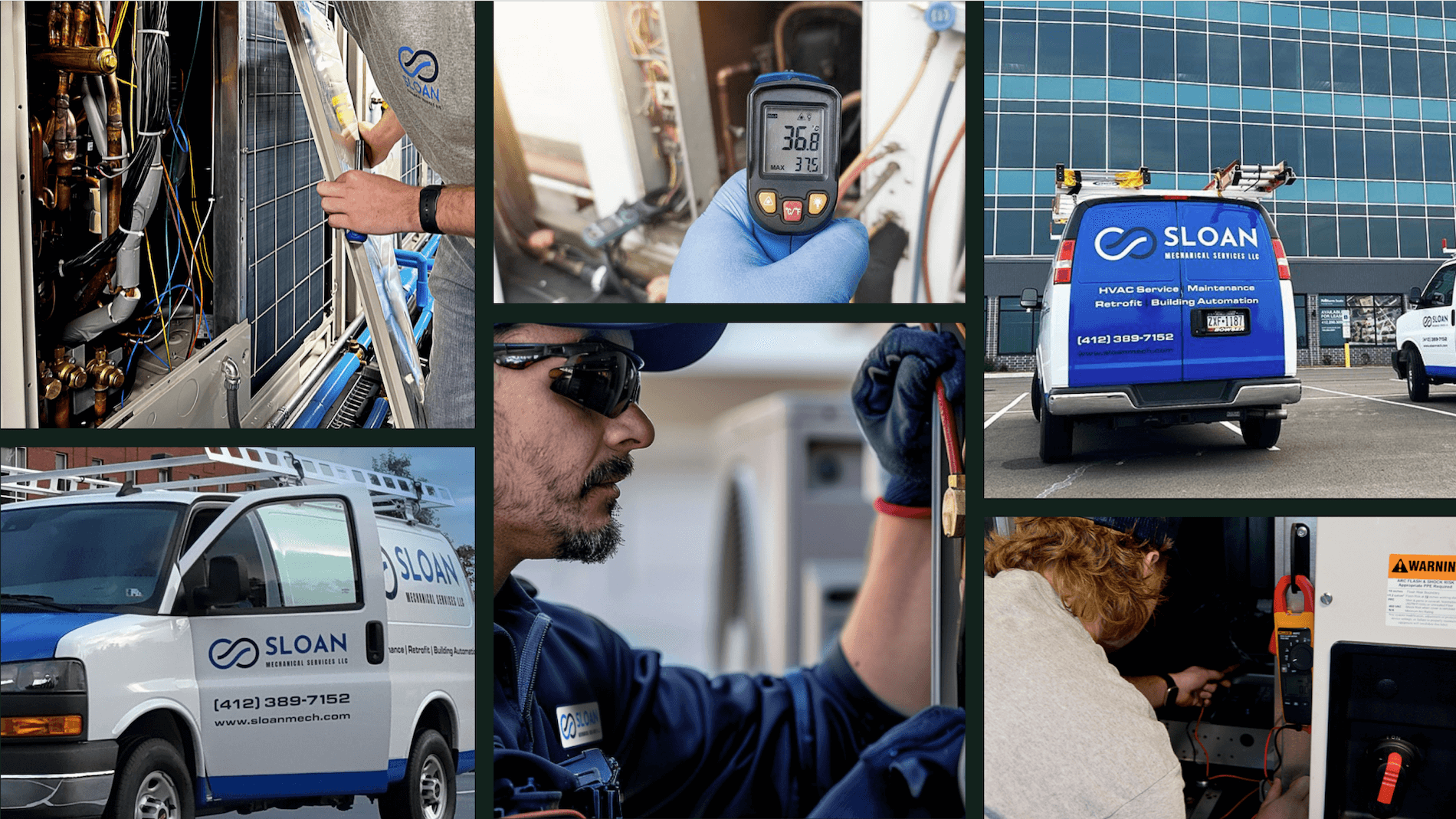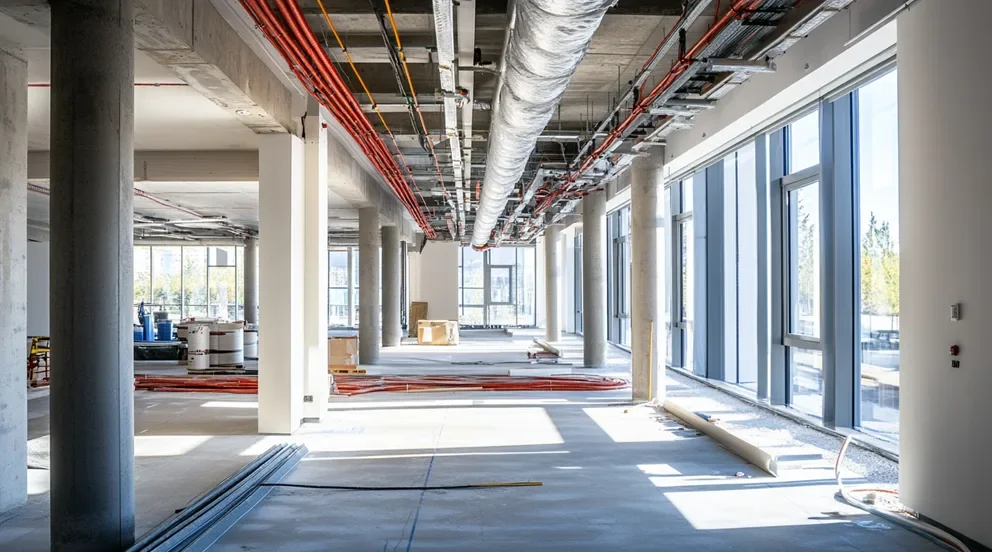Managing a plumbing business means juggling quotes, jobs, and invoices—all while keeping the crew moving and the numbers right. If your team is still buried in paper estimates or chasing down cost sheets, you’re not alone. A solid plumbing pricing app can take that mess and turn it into fast, accurate pricing your techs can trust.
These apps help you nail quotes, protect profit margins, and build customer trust with consistent, professional pricing—on-site or in the office. If you’re in the plumbing industry, upgrading your pricing tools could be one of the smartest moves you make this year.
Here’s what we’ll cover:
- Choosing the right plumbing pricing app for your team
- 5 key features to look for in a plumbing pricing app
- Types of plumbing pricing apps
- 8 best plumbing pricing apps for technicians and teams
- 7 benefits of plumbing pricing apps for contractors
- 4 important pricing app FAQs answered for plumbers
Let’s face it—there’s no shortage of tools out there claiming to solve your pricing problems. But picking a plumbing pricing app is about finding something that fits your workflow, your techs, and your bottom line. The next section breaks down how to choose a pricing app that actually works for your team—without slowing things down.
Choosing the right plumbing pricing app for your team
A plumbing pricing app should make quoting easier, not harder. Whether your team handles residential calls, large commercial jobs, or both, the goal is the same—accurate, consistent pricing that’s fast to build and easy to explain. Before committing to any platform, it’s worth asking the right questions to see how well it lines up with your crew’s workflow.
- Workflow compatibility – Does this app fit how your plumbers quote, schedule, and invoice? Will it work smoothly with your current systems or require a full overhaul?
- Tech adoption – Is the app something your field techs can use without needing a training manual? Are they comfortable using tablets or phones on the job to price work accurately?
- Customer experience – Will this app help your team deliver faster, more professional quotes to customers? Does it allow for digital approvals, clear pricing breakdowns, and quick turnaround?
- Scalability – Can the app grow with your business? Whether you’ve got five trucks or fifty, does the tool support multi-user access, job tracking, and pricing templates for larger operations?
- Key features – Does it offer flat-rate pricing, cost calculators, estimate-to-invoice conversion, or integration with inventory? What features actually matter to your techs and your bottom line?
Once you’ve nailed down what your team needs, it’s time to dig into the features that make a pricing app stand out. From quoting on-site to closing jobs faster, the next section breaks down the five must-have capabilities every plumbing team should keep an eye out for.
5 key features to look for in a plumbing pricing app
The best plumbing pricing apps don’t just handle numbers—they help crews stay sharp in the field, win work faster, and keep jobs moving without bottlenecks. Whether you're quoting on-site, following up with an invoice, or juggling a full schedule of emergency calls, the right features turn good techs into revenue drivers.
Let’s say your lead tech is out on a Saturday emergency call, fixing a cracked main line at a commercial property. He’s wrapping up the repair and needs to get a quote for additional work approved before leaving. The ability to build and send a clean estimate—on-site, on a mobile device—can be the difference between landing the upsell or losing that revenue. That’s where these features come in.
1. Field-ready mobile access
A plumbing pricing app must support your techs in the field—not slow them down. Mobile access means they can create estimates, update prices, and send invoices without waiting on office staff. Take a scenario where a technician is finishing up a sewer line repair and the customer asks about re-routing an old section of pipe. With a technician mobile app, they can pull up pricing, add the line item, and send an estimate right there. No clipboard, no callbacks. Just clear, fast communication—and more work locked in.
2. Built-in scheduling and dispatch visibility
Your pricing app shouldn’t live in a silo. It should tie directly into your dispatch board so you know what’s quoted, what’s approved, and what’s ready to schedule. Let’s say your office gets a call from a customer who accepted a quote on-site. The tech already submitted it through the app. With field service dispatch software, your dispatcher sees the approved quote and slots the follow-up job without digging through emails or calling techs. Less miscommunication. Faster turnaround.
3. CRM integration for job history and customer context
Quotes don’t exist in a vacuum. When pricing tools are connected to a CRM, your techs get context: past repairs, service frequency, customer notes—everything they need to price smarter. Let’s say you’ve been to a property five times for water heater issues. On the sixth visit, your tech needs to recommend a replacement. With CRM systems for plumbing contractors, they are able to pull up the entire job history and use that info to justify the quote. The customer sees you're tracking issues, not just pushing sales—and that builds trust.
4. Time tracking and labor cost calculation
A strong plumbing price app needs to factor in labor with precision. If it doesn’t tie into your team’s time tracking, you’re guessing on hours—and potentially underpricing jobs. Picture this: a two-person crew spends half a day diagnosing and replacing a failed pressure regulator. If time isn’t tracked accurately, your quote might leave out real labor costs. With time tracking, those hours feed directly into the pricing engine, giving you clean, accurate labor numbers that protect your margins.
5. Integrated payment tools
The best pricing app doesn’t just quote—it closes. Integrated payments mean your techs can get approval, send the invoice, and collect payment without extra steps or third-party tools. Say a customer approves a $1,400 estimate for pipe replacement. Your tech finishes the work and wants to wrap things up. With payments tools, they send the invoice and collect on-site—no delays, no chasing down checks later. That kind of speed boosts cash flow and keeps your back office clean.
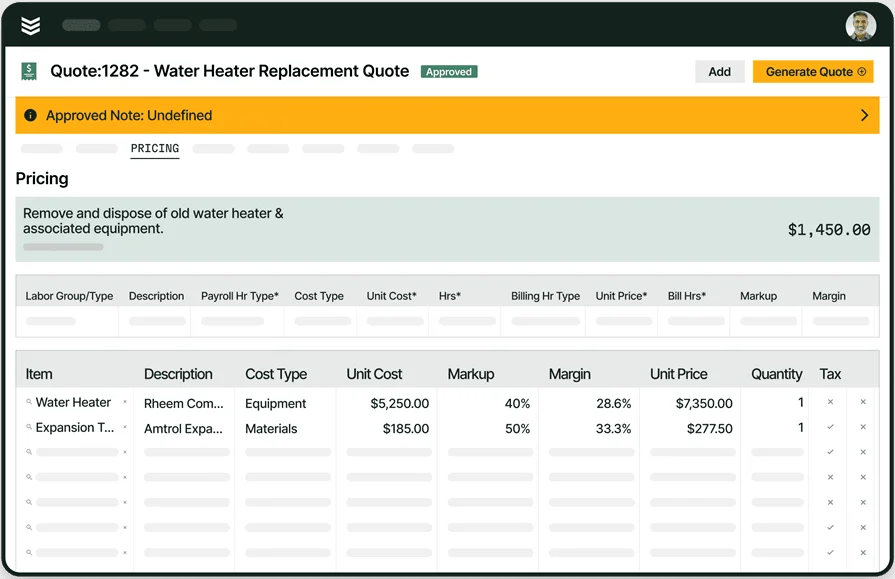
Price projects accurately
Improve job estimates so you can quote projects right and increase profits.
Other notable features to look for in a plumbing pricing app
While the core features get most of the spotlight, there are a few additional tools that can boost how well your plumbing pricing app performs in day-to-day use. These aren’t always top of the list, but they do help teams run leaner and faster behind the scenes.
- Service agreement tools: If your shop handles recurring maintenance or long-term contracts, service agreements help standardize pricing across those jobs. This keeps estimates consistent and makes recurring work easier to quote and renew.
- Pipeline visibility: Keeping track of open quotes and their status can shape your follow-up process. With pipeline tools, you’ll see what’s been sent, what’s been approved, and what needs chasing—helping sales and ops stay aligned.
- Reporting dashboards: Strong reporting isn’t just for the back office. Integrated reporting features let you track estimate-to-close ratios, average ticket values, and top-performing techs—so you can fine-tune your pricing strategy based on real data.
You’ve seen what features matter—now it’s time to think about format. Not every shop needs the same setup. Some teams work best with cloud-based tools, others need mobile-first solutions that run fast on the go. In the next section, we’ll break down the types of plumbing pricing apps out there—and what kind of setups work best for different types of plumbing businesses.
Types of plumbing pricing apps
The way a plumbing pricing app is built can change how well it fits your business. Some tools are built for flexibility in the field, others focus on deep office control. Whether you run residential service calls or manage multiple commercial crews, knowing the different types of apps helps you choose the setup that matches how your team actually works.
- Cloud-based: These apps store everything online, so your team can access pricing data, estimates, and job updates from anywhere. They’re ideal for mobile crews and shops that need flexibility. One downside? You’ll need a reliable internet connection to keep things running smoothly. Learn more about cloud-based field service management software and how it fits into modern plumbing operations.
- On-premise: Installed on local servers, these systems give you complete control and keep your data in-house. That’s a plus for companies with strict IT policies or limited connectivity. But they’re harder to update and rarely integrate well with mobile tools—slowing down field-to-office communication.
- Mobile: These apps are built with your techs in mind. They’re fast, intuitive, and made for use on tablets or phones. Mobile apps shine when your team is pricing jobs on-site, but if they aren’t tied into back-office systems, you could miss out on data syncing, job tracking, or real-time approvals.
- All-in-one field service platforms: These bring pricing, dispatch, CRM, time tracking, and reporting under one roof. They’re built for full-service visibility—ideal for growing plumbing businesses that need to connect quoting to every other step in the job cycle. If you're looking for seamless integration across teams, a field service management platform is worth a serious look.
In the next section, we break down the top plumbing pricing apps being used by contractors today—what they do well, where they fall short, and which ones deliver the most value for technicians and teams.
8 best plumbing pricing apps for technicians and teams
Every shop has its own flow, and the plumbing pricing app you choose should match how your team operates day to day. Some apps shine in the field, helping techs quote faster and close jobs on-site. Others are better suited for back-office pros managing bids across dozens of crews. Below, we break down the top apps in the market—what they do well, what to watch out for, and who they work best for.
1. Best for commercial: BuildOps
BuildOps delivers a serious advantage for commercial plumbing contractors who manage complex estimates and multi-phase jobs. It’s designed to keep your field and office connected—while offering precise control over pricing, quoting, and invoicing across every project stage. For shops that juggle high volumes and long-term contracts, it brings speed, accuracy, and professionalism to every estimate.
App Type: Cloud-based, mobile-friendly, all-in-one field service platform
How Pricing Works: BuildOps uses a custom-quoted pricing model tailored to the size and needs of your business. You’ll need to book a demo to get exact pricing details.
Features Beyond Pricing: Beyond quoting prices, BuildOps includes powerful dispatching, time tracking, project management, CRM features, reporting and analytics, and pipeline management. It integrates estimating directly into your workflows, from creating a job to invoicing and follow-up. With its construction quoting software and invoicing tools, your team can go from bid to bill without bouncing between systems or wasting hours on admin work.
What Sets It Apart for Commercial: BuildOps was developed specifically for commercial contractors—so it understands the complexity of your jobs. It handles multi-location clients, high-ticket quotes, recurring work, and detailed reporting. It’s not just fast—it’s built to handle big workflows without breaking under pressure.
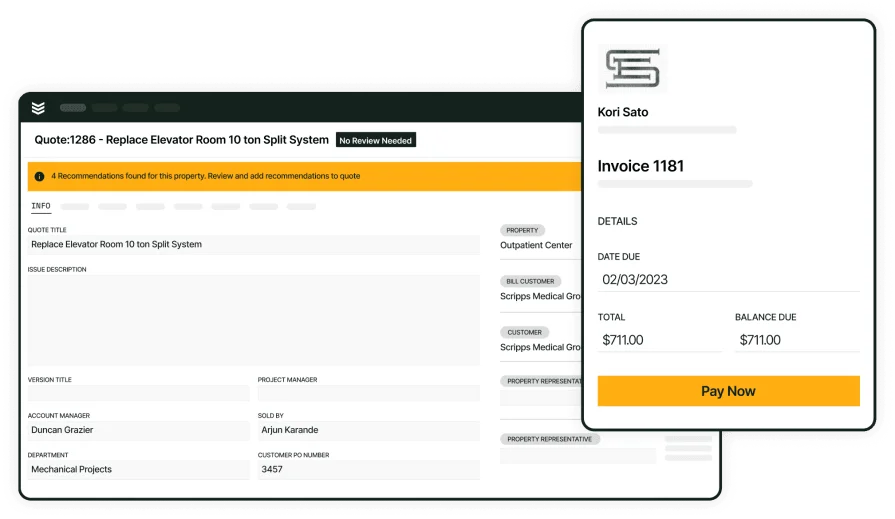
Take a closer look
Streamline pricing from the first estimate to the final payment.
2. Best for small to mid-sized businesses: Jobber
Image Source: Jobber
Jobber gives small plumbing shops a simple way to handle quoting, scheduling, and invoicing—all in one user-friendly interface. It’s especially effective for contractors looking to digitize without overcomplicating their systems. However, businesses with larger teams or more advanced operational needs may find themselves limited by Jobber’s scope and customization options.
App Type: Cloud-based, web-based solution
How Pricing Works: Plans start at $25/month for one user, and scale based on features
Features Beyond Pricing: Jobber offers a clean mobile app, calendar-based scheduling, invoice tracking, and client communication tools. Its automation features help smaller teams stay on top of follow-ups and get paid faster.
What Sets It Apart for SMBs: Ideal for 1–10 tech shops that want to quote quickly and keep jobs organized without a steep learning curve.
3. Best for general contractors: STACK
Image Source: STACK
STACK is purpose-built for preconstruction planning—making it ideal for plumbing contractors who partner with general contractors or bid on large commercial jobs. It offers robust takeoff tools, line-item pricing, and digital plan markups to streamline the estimating phase. However, STACK isn’t meant for day-to-day service management or field-based quoting, which limits its use beyond the bid phase.
App Type: Cloud-based
How Pricing Works: Free trial available; paid plans start around $2,999/year for one user
Features Beyond Pricing: Digital takeoffs, markup tools, document sharing, and collaborative bidding tools. These features help plumbing contractors stay competitive when bidding on new construction or large-scale projects.
What Sets It Apart for General Contractors: STACK is strong in blueprint-based estimating and detailed pricing breakdowns for complex plumbing scopes.
4. Best for residential: ServiceTitan
Image Source: ServiceTitan
ServiceTitan is widely used by residential plumbing contractors who want an end-to-end solution with flat-rate pricing tools, customer communication features, and a slick mobile app for field techs. It’s strong in helping techs quote fast in the home and upsell on the spot. However, ServiceTitan can feel bloated for smaller operations and lacks the flexibility some commercial contractors need, as it only offers software services for flat-rate pricing.
App Type: Cloud-based, web-based solution
How Pricing Works: Custom pricing based on company size and selected features
Features Beyond Pricing: Includes job costing, automated reminders, dispatch, and customer follow-ups. Its flat-rate pricing library helps ensure consistency across techs and jobs, especially for high-volume residential service.
What Sets It Apart for Residential: The platform makes quoting and scheduling simple for in-home service calls while supporting upsells through real-time mobile tools.
5. Best for independent contractors: Joist
Image Source: Joist
Joist is built for independent plumbers who need a fast and easy way to quote jobs, send invoices, and collect payments—all from a mobile device. The app is designed to remove friction from solo operations and offer a polished experience for homeowners. However, Joist lacks features like crew scheduling, dispatch, and job tracking, which makes it unsuitable for shops managing multiple technicians or long-term projects.
App Type: Cloud-based, mobile-first
How Pricing Works: Free version available; Pro plans start at roughly $13/month
Features Beyond Pricing: Offers customizable quote templates, digital signatures, simple invoicing, and built-in payment processing. It’s efficient without being overwhelming.
What Sets It Apart for Independent Contractors: Perfect for one-person plumbing businesses that want to maintain a professional image and get paid quickly.
6. Best for ease of use: Service Fusion
Image Source: Service Fusion
Service Fusion is known for its clean interface and quick setup, making it a solid choice for plumbing contractors who want simple, easy-to-use quoting tools. Its flat-rate pricing features and all-in-one dashboard help smaller teams stay organized without needing hours of training. While it covers essential workflows, it doesn’t offer deeper customization or reporting features that larger commercial teams may require.
App Type: Cloud-based, web-based solution
How Pricing Works: Pricing starts at $126/month for the base plan
Features Beyond Pricing: Service Fusion supports scheduling, invoicing, flat-rate libraries, payment processing, and GPS tracking. It’s designed to simplify operations without sacrificing functionality.
What Sets It Apart for Ease of Use: Great for teams that want something up and running fast, with minimal onboarding and strong mobile usability.
7. Best for plumbing owners and designers: Field Promax
Image Source: Field Promax
Field Promax targets plumbing businesses that want to manage quoting, scheduling, and workflow design from a single system. It offers flexible customization and workflow templates tailored to plumbing teams. However, compared to newer platforms, its interface and navigation feel less modern and may take longer to learn for teams new to software tools.
App Type: Cloud-based, web-based solution
How Pricing Works: Plans start at around $49/month per user
Features Beyond Pricing: Includes job management, scheduling, estimate creation, team assignments, and digital approvals. It’s especially useful for plumbing companies that deal with design-to-build projects.
What Sets It Apart for Owners and Designers: Offers a mix of task flexibility and planning tools, helping leaders stay ahead of both service and install work.
8. Best for specialty contractors: Zuper
Image Source: Zuper
Zuper is designed for plumbing contractors with specialty services that require multi-phase jobs, detailed documentation, or compliance tracking. It offers deep customization, mobile workflows, and integration with platforms like Zendesk and QuickBooks. However, its broad feature set may overwhelm smaller teams or those focused on high-speed residential work.
App Type: Cloud-based, web-based
How Pricing Works: Custom pricing depending on company needs and usage
Features Beyond Pricing: Route optimization, job status updates, inventory tracking, service-level agreements, and checklist automation.
What Sets It Apart for Specialty Contractors: Ideal for plumbing teams that work in regulated environments, do design-build, or need layered workflows built into their quoting and dispatch system.
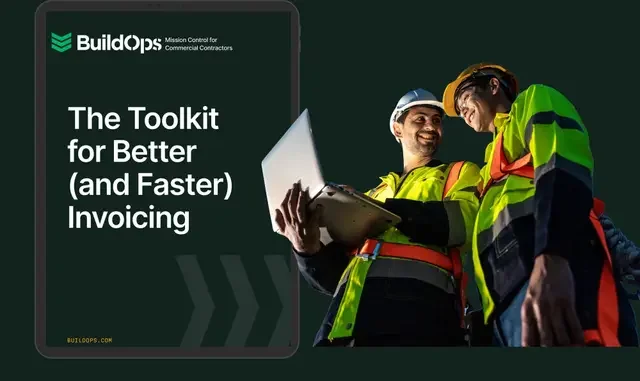
Always get paid on time
Don’t just price jobs right—cut costs and make sure you’re paid faster.
7 benefits of plumbing pricing apps for contractors
Running a plumbing business means making every hour count—on the job and off it. A good plumbing pricing app doesn’t just help you build quotes; it improves how your entire team works. From tighter billing cycles to better customer conversations, here’s how the right app turns everyday tasks into real business wins.
1. Less time spent quoting jobs
Manual quoting eats up valuable time, especially when techs are bouncing between spreadsheets, old price books, or handwritten notes. A pricing app automates the process, letting your team build and send quotes within minutes—right from the job site. With fewer errors and faster turnaround, you get back time to book more jobs or tackle higher-value work.
2. Faster invoice turnaround and better cash flow
When pricing is directly tied into your invoicing flow, billing doesn’t fall through the cracks. A good plumbing pricing app lets your techs convert estimates into invoices on the spot, helping you collect payments sooner. Using a smart plumbing invoice template makes this process even smoother—ensuring your invoices look professional and include all the info needed to get paid fast.
3. Consistent pricing across every technician
Consistency is key when you’re quoting jobs at scale. Pricing apps remove the guesswork by giving every tech access to the same labor rates, material costs, and service bundles. This reduces pricing disputes and keeps your crew aligned. With plumbing flat rate pricing software, it’s easy to apply standardized rates that reflect your actual overhead and profit goals.
4. Improved customer trust with clear pricing breakdowns
No one likes vague pricing—especially customers. Plumbing pricing apps help you present itemized quotes that break down labor, materials, and additional charges in a way that’s easy to understand. According to our plumbing flat rate pricing guide, transparent pricing not only builds trust, it also increases the likelihood of closing the job on the first visit.
5. Better tracking of what’s quoted vs. what’s won
When quotes are buried in emails or paper files, it’s hard to follow up—or even know what’s still open. Plumbing pricing apps track every estimate, its status, and any changes made. This gives sales and operations teams a live view of the pipeline, helping them follow up faster and close more work. A plumbing pricing software solution with quote tracking ensures no opportunity slips through the cracks.
6. More upsell opportunities in the field
When techs can access service bundles and optional add-ons within the pricing app, they’re better equipped to upsell during the job—without needing approval from the office. Whether it’s offering a whole-house shutoff valve or replacing aging pipes alongside a water heater install, plumbing pricing tools make upselling part of the workflow instead of an afterthought.
7. Stronger customer relationships through better follow-ups
A pricing app that connects to your CRM allows you to keep records of past quotes, customer preferences, and service history. That means faster follow-ups, repeat business, and better retention. With a connected CRM for plumbers, you can see every quote sent, track approvals, and reach back out at just the right time to close a deal or recommend future service.
4 important pricing app FAQs answered for plumbers
You’ve heard the buzz about pricing apps—but what do they actually do, and how do they fit into a plumber’s daily workflow? Whether you’re running a two-truck shop or managing multiple teams, having a clear understanding of how these tools function (and what they cost) can help you make smarter business decisions. Let’s break down the key questions plumbing contractors are asking.
1. What is a plumbing pricing app?
A plumbing pricing app is a tool that helps contractors build accurate job estimates, apply flat-rate pricing, and create invoices from a phone, tablet, or computer—all in real time. It centralizes labor rates, material costs, and service pricing to keep your quotes consistent and professional.
Beyond just estimating, these apps often connect with your CRM, scheduling, and payment systems—streamlining the entire sales-to-payment process. They’re designed to help plumbing teams quote faster, cut down on manual errors, and make pricing easy to manage, even in the field.
2. How do pricing apps work for plumbing contractors?
Plumbing pricing apps work by connecting your team’s real-world tasks—like quoting, invoicing, and collecting payment—to a digital system that makes everything faster and more accurate. These tools pull labor rates, materials, and flat-rate pricing into one place so your crew can build estimates on the fly and bill with confidence. Here's how it typically plays out:
- Access service pricing from a centralized database
- Use templates to build consistent quotes in the field
- Convert estimates into invoices with a few taps
- Sync with your CRM to track customer info and job history
- Add photos, notes, and recommended repairs into quotes
- Accept digital signatures and approvals from customers
- Tie invoices directly to job records for better tracking
- Collect payment on the spot or send follow-up billing
Whether you're quoting a water heater replacement or a whole-system install, pricing apps help you keep your workflow tight and your margins accurate.
3. Is the cost of pricing apps worth it for plumbers?
Yes—when used correctly, the return outweighs the investment. The value comes from time saved, jobs won, and revenue secured. By eliminating manual quoting, reducing missed charges, and speeding up invoicing, pricing apps often pay for themselves within the first few jobs. For teams dealing with pricing inconsistencies or slow approvals, the cost of doing nothing is much higher than investing in a system that keeps your numbers sharp and your workflow efficient.
4. Best practices for implementing a plumbing pricing app
Rolling out a pricing app doesn’t need to be complicated, but it does need to be intentional. Here’s how to get it right the first time:
- Start with your current workflow – Identify bottlenecks in how your team quotes and invoices
- Get techs involved early – Field feedback from those who’ll be using the app daily
- Standardize your pricing catalog – Clean up labor rates, parts lists, and flat-rate services
- Train in real scenarios – Practice quoting actual jobs, not hypothetical ones
- Use mobile devices – Make sure techs can access the app on phones or tablets
- Connect it to your CRM – Link customer records for better follow-ups
- Track estimate-to-invoice conversion – Use metrics to monitor adoption and results
- Review weekly – Get early feedback and adjust your workflows as needed
Getting the most out of your plumbing pricing app starts with the right foundation—and a team that knows how to use it confidently in the field.
Plumbing pricing apps aren’t just helpful—they’ve become essential for shops looking to stay competitive. From reducing quoting errors to speeding up invoice approvals, the tools we’ve covered here solve problems that cost real time and real money. But finding one that covers all the bases—especially for commercial contractors—isn’t easy.
That’s where BuildOps stands out. As a full platform built for commercial field service work, it brings quoting, dispatch, invoicing, and scheduling under one roof. While many tools force you to juggle disconnected systems, BuildOps gives you everything you need to price confidently, win jobs faster, and keep the back office in sync.
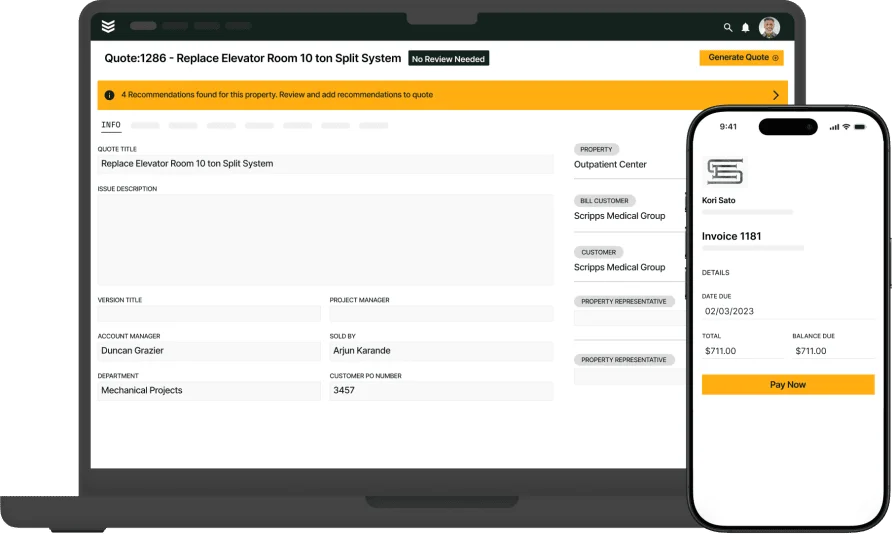
See BuildOps in action
We support your estimating and invoicing workflow so your team can work smarter.



